Spotted woodpecker with a white back
Photos: Arne Ader
Translation: Liis
White-backed spotted woodpecker
White-backed woodpecker Valgeselg-kirjurähn Dendrocopos leucotos
Great spotted woodpecker Suur-kirjurähn Dendrocopos major
In autumn a massive migration of woodpeckers passed through Estonia. The cone harvest was meagre, but they could still be seen and heard – chopping in mornings near the forest camera.
The number of great spotted woodpeckers is certainly ten times higher in winter, and we meet them in forests, parks and gardens. They are roughly the same size as the white-backed woodpecker; in humid broadleaf forests which are favoured habitats of the white-backed woodpecker, careful attention is needed particularly when the colours of the bird are somehow not quite familiar – it may be a white-backed one …
Their plumage is similar to that of the much smaller lesser spotted woodpecker (Dendrocopos minor): bright red colour where woodpeckers usually have it, breast plumage streaked, and we don’t see the white shoulder patches of the great spotted woodpecker. The white-backed woodpecker is more than a quarter of a metre long and weigh over a hundred grams. The call is a „kjvk“, softer than that of the great spotted woodpecker. The beak is pewter grey, eye colour reddish brown, legs dark grey, two toes forward and two backwards – so eight altogether.
They feed on wintering insects or their grubs that they find on deciduous trees, and particularly on decaying trees. Sometimes you can find areas where tree stumps have been hacked into splinters – something was to be had there.
White-backed woodpecker observations: LINK
Great spotted woodpecker observations: LINK
Great spotted woodpecker










